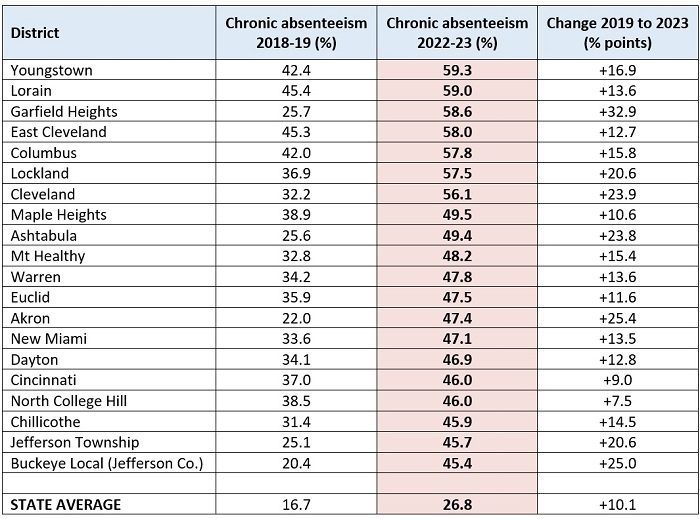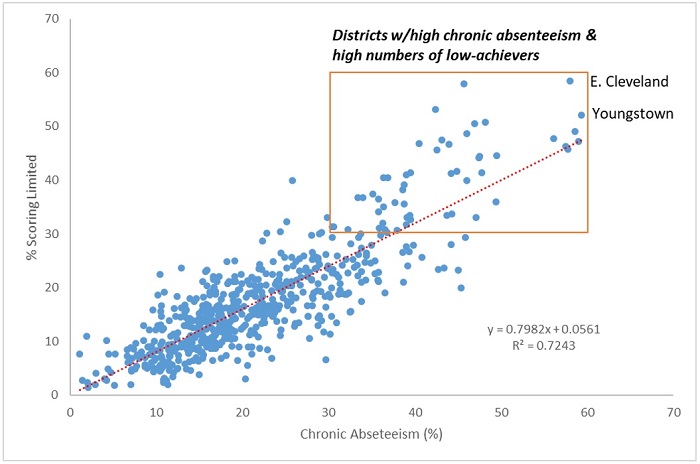School report cards are out, and the results reveal the persistent challenges facing Ohio students in the aftermath of pandemic-era disruptions to education. While test scores ticked up in 2022–23 relative to last year, math scores remain substantially below pre-pandemic levels and achievement gaps remain wide. In Columbus and Dayton school districts, for example, 46 and 51 percent of students, respectively, scored “limited” on state assessments—the lowest mark—roughly double the proportion of students at this level statewide (23 percent).
Accelerating student learning remains a moral imperative, and a continuing challenge for Ohio’s policymakers and educational leaders. There has been much discussion about how to boost achievement, but one of the most basic ways to move the needle might be hiding in plain sight: simply making sure that students attend school.
Unfortunately, absenteeism soared during the pandemic and remains at alarmingly high levels. Statewide, chronic absenteeism rates increased from 17 to 27 percent between 2018–19 and 2022–23. That translates to 418,382 students who were chronically absent last year. Such students miss more than 10 percent of the school year for any reason, whether excused or unexcused. Based on a 180-day year, that is equivalent to eighteen or more days of school—nearly a month worth of learning. That’s a lot of valuable instructional time lost.
The state average masks the sky-high rates of absenteeism across many Ohio districts. The table below indicates that more than half of students were chronically absent in Youngstown, Lorain, Garfield Heights, East Cleveland, Columbus, Lockland, and Cleveland. Staggering rates of absenteeism are also evident in big-city districts such as Akron, Dayton, and Cincinnati, as well as smaller districts such as Ashtabula, Chillicothe, and Buckeye Local. As the rightmost column indicates, chronic absenteeism rates were significantly up in 2022–23 compared to pre-pandemic levels. In Youngstown, chronic absenteeism rates were 17 percentage points higher than in 2018–19; rates skyrocketed by 33 points in Garfield Heights—the largest increase of any Ohio district.
Table 1: Districts with the highest rates of chronic absenteeism in 2022–23

Districts with high chronic absenteeism rates tend to have large numbers of low-achieving students. The figure below displays the correlation between chronic absenteeism and the percentage of students scoring “limited”—again, the lowest achievement level on state exams. The districts in the top right corner of the figure (outlined in orange) had chronic absenteeism rates of 30 percent or higher and more than 30 percent of students scoring limited in 2022–23. At the very top right of the chart, we see East Cleveland, where 58 percent of students were chronically absent and 58 percent of students scored limited. In Youngstown, 59 percent of students were chronically absent and 52 percent scored limited.
Figure 1: Relationship between chronic absenteeism and low student achievement in Ohio districts, 2022-23

Of course, multiple factors lead to low achievement, including poverty and ineffective instruction. But poor attendance contributes to these academic deficiencies, as well. Moreover, low achievement can further depress attendance, as struggling students get frustrated and decide not to attend school. A recent analysis of national assessment data suggests that the spike in chronic absenteeism played a major role in pandemic-era learning loss.
To their credit, national and state leaders are recognizing the importance of school attendance. President Biden recently called for an “all-hands-on-deck approach” to combatting the wave of chronic absenteeism. Before him, President Trump pushed for schools to reopen faster, recognizing the critical role in-person instruction plays in student learning. Closer to home, the Ohio Department of Education has declared an “attendance crisis,” and noted on this year’s state report card that “missing too much school has detrimental effects on a student’s learning trajectory.” Just prior to the pandemic, community leaders launched the Stay in the Game! initiative to encourage attendance; that program takes on greater importance (and could be expanded) as chronic absenteeism has become more prevalent in Ohio.
Making sure that students are in school will take even more concerted efforts on the part of Ohio’s leaders, schools, and parents. On a leadership level, state and local leaders should continue to communicate a strong, consistent message that attending school is essential to student success. And Ohio legislators should stand firm in state efforts to reduce chronic absenteeism and not tamper with policies that promote consistent attendance (there is a misguided proposal that would do just this). They should insist on complete and accurate attendance data collections, and could even explore a value-added-type measure that would shine light on schools, including high-poverty ones, that are most effective at improving attendance.
Meanwhile, schools can take practical steps to support better attendance. Here are four (and more can be found in a recent EdResearch for Recovery brief and Tim Daly’s terrific essay):
- Set clear expectations that coming to school is the norm. Schools can do this through messaging and “level setting,” but also through concrete actions, such as making school cancellations exceedingly rare, resisting the urge to adopt four-day weeks or revert to remote learning, and ensuring that educators are also in attendance every day (teacher attendance has also slipped).
- Ensure that students receive reliable transportation. Unfortunately, some districts have struggled with transportation in recent years, and families say spotty transportation can be a significant barrier to attendance.
- Make school start times later. This could ease the morning crunch that may lead to poor attendance (e.g., missing the bus) or tardiness, while also allowing students to get more sleep, which is related to better learning outcomes.
- Implement a text-messaging system to communicate with parents. A few studies indicate that simply sending parents a message expressing concern and offering assistance can help reduce absenteeism.
Speaking of parents, they should also be enlisted in the fight against chronic absenteeism. Moms and dads can make sure that their kids are up and ready to go in the mornings and getting plenty of sleep at night. For parents of adolescent children, they can make sure screens are off at a reasonable hour and phones are left outside bedrooms. They can reinforce to older children just how important it is to attend school, even if they’re not seeing the value of school in the moment. Parents should plan appointments and vacations at times that don’t interfere with school and resist pressure from their children to allow them to stay at home. With educational choice expanding in Ohio, parents can also work to find schools where their children feel motivated to learn and have a stronger sense of belonging. (Lack of interest in schoolwork and bullying are two reasons why students may not show up.)
The pandemic knocked thousands of Ohio students off track and widened already unacceptably large achievement gaps. Too many students, however, are still missing significant chunks of class time, and that is making academic progress all the more difficult. Making sure that state and community leaders, schools, and parents are on the same page about the importance of attendance—and taking actions to encourage it—would be a great step toward ensuring that all students are catching up.


